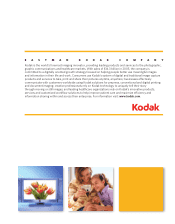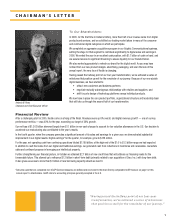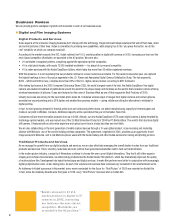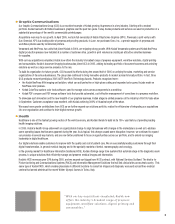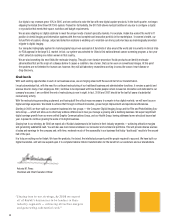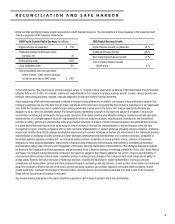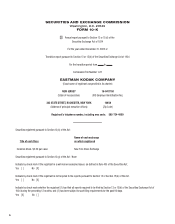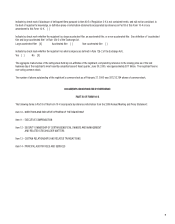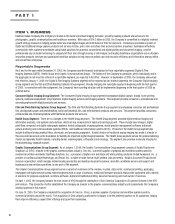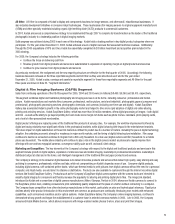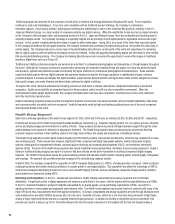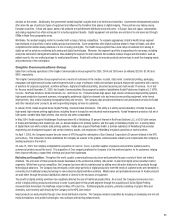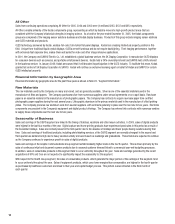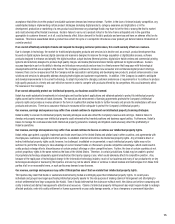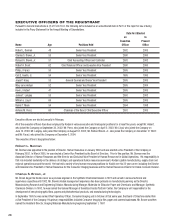Kodak 2005 Annual Report Download - page 12
Download and view the complete annual report
Please find page 12 of the 2005 Kodak annual report below. You can navigate through the pages in the report by either clicking on the pages listed below, or by using the keyword search tool below to find specific information within the annual report.10
Traditional products and services for the consumer are sold direct to retailers and through distributors throughout the world. Price competition
continues to exist in all marketplaces. To be more cost competitive with its traditional product offerings, the Company is continuing to
rationalize capacity. As previously outlined, digital product offerings are substituting for some of the traditional fi lm products, primarily in the U.S.,
Japan and Western Europe, as a large number of consumers actively use digital cameras. While this substitution to date has had an impact primarily
on the Company’s fi lm and paper sales, and processing services in the U.S., Japan and Western Europe, there are moderating and declining sales in
emerging markets as well. The Company’s strategy is to partially mitigate this by providing its own digital products, digitization services and output
services. In fact, growth in digital printing often leads to output on silver halide paper. During 2005, as a result of the faster-than-expected decline
in the Company’s traditional fi lm and paper business, the Company extended and accelerated its restructuring actions, and revised the useful lives of
certain assets. The Company has sold or closed many of its photofi nishing laboratories in certain parts of the world and repositioned its remaining
labs for digital output as well as traditional processing services for retailers. Kodak also supplies photographic papers and chemicals to other entities
that provide photofi nishing services. The Company’s remaining laboratories provide consumers the opportunity to receive fi lm images in traditional
formats or digital form, such as a Picture CD.
Traditional and digital professional products and services are sold direct to professional photographers and laboratories, or through dealers throughout
the world. Although the Company continues to provide better performing and innovative traditional fi lms and papers, the focus has shifted towards
new products, systems and solutions focused on improving the digital workfl ow for professional photographers and laboratories. These solutions
range from digital capture devices (digital cameras and scanners) designed to improve the image acquisition or digitalization process, software
products designed to enhance and simplify the digital workfl ow, output devices (thermal printers and digital silver halide writers) designed to produce
high quality images, and media (thermal and silver halide) optimized for digital workfl ows.
Throughout the world, almost all entertainment-imaging products are sold direct to studios, laboratories, independent fi lmmakers or production
companies. Quality and availability are important factors for these products, which are sold in a price-competitive environment. When the
entertainment industry adopts digital formats, the Company anticipates that it will face new competitors, including some of its current customers
and other electronics manufacturers.
Kodak’s advertising programs actively promote the segment’s products and services in its various markets, and its principal trademarks, trade dress
and corporate symbol are widely used and recognized. Kodak is frequently noted by trade and business publications as one of the most recognized
and respected brands in the world.
Health Group Segment
Sales from continuing operations of the Health Group segment for 2005, 2004 and 2003 were (in millions) $2,655, $2,686 and $2,431, respectively.
Products and services of the Health Group segment enable healthcare customers (e.g., hospitals, imaging centers, etc.) to capture, process, integrate,
archive and display images and information in a variety of forms. These products and services provide intelligent decision support through the entire
patient pathway from research to detection to diagnosis to treatment. The Health Group segment also provides products and services that help
customers improve workfl ow in their facilities, which in turn helps them enhance the quality and productivity of healthcare delivery.
The Health Group segment provides digital medical imaging and information products, and systems and solutions, which are key components of sales
and earnings growth. These include laser imagers, digital print fi lms, computed and digital radiography systems, dental radiographic imaging
systems, dental practice management software, advanced picture-archiving and communications systems (PACS), and healthcare information
systems (HCIS). Products of the Health Group segment also include traditional analog medical fi lms, chemicals, and processing equipment. Kodak’s
history in traditional analog imaging has made it a leader in this area and has served as the foundation for building its important digital imaging
business. The Health Group segment serves the general radiology market and specialty health markets, including dental, mammography, orthopedics
and oncology. The segment also provides molecular imaging for the biotechnology research market.
In March 2005, the Company completed the acquisition of OREX Computed Radiography Ltd. (OREX), a leading provider of compact, robust computed
radiography systems that enable medical practitioners to acquire patient x-ray images digitally. This acquisition has added the technology of OREX’s
small format computed radiography products for use in various health imaging markets, such as orthopedics, diagnostic imaging centers, dentistry,
and industrial non-destructive testing (NDT).
Marketing and Competition: In the U.S., Canada and Latin America, health imaging consumables and analog equipment are sold through
distributors. A signifi cant portion of digital equipment and solutions is sold direct to end users, with the balance sold through distributors and OEMs.
In the U.S., individual hospitals or groups of hospitals represented by, as buying agents, group purchasing organizations (GPOs), account for a
signifi cant portion of consumables and equipment sales industry-wide. The Health Group segment has secured long-term contracts with many of the
major GPOs and, thus, has positioned itself well against competitors. In Europe, consumables and analog equipment are sold through distributors and
value added service providers (VASPs) as well as direct to end users. Hospitals in Europe, which are a mix of private and government-funded types,
employ a highly regimented tender process in acquiring medical imaging products. In addition to creating a competitive pricing environment, this
process can result in a delay of up to 6 to 18 months between the time the tender is delivered to the hospital and the time the hospital makes a


